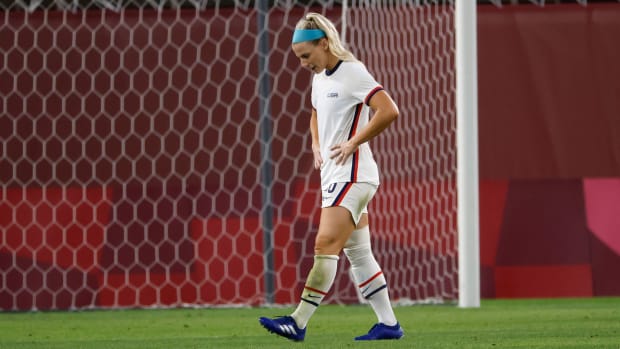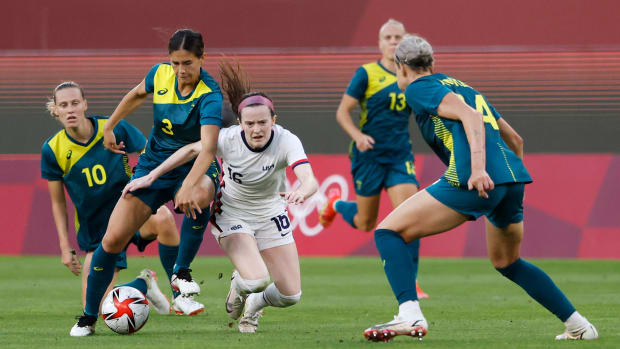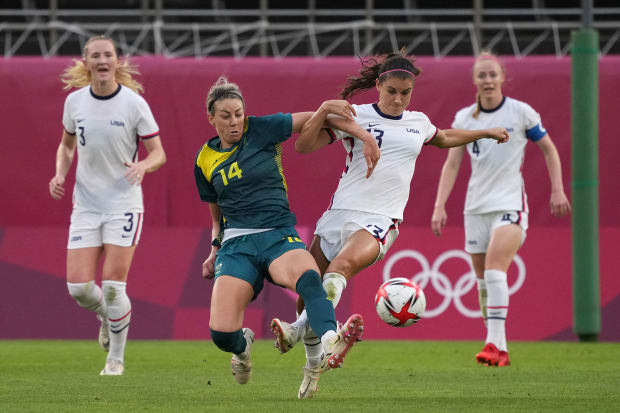A scoreless draw vs. Australia put a bow on a largely lackluster and subpar group stage. Can the U.S. flip the switch in the knockout rounds?
Sign up for our free daily Olympics newsletter: Very Olympic Today. You'll catch up on the top stories, smaller events, things you may have missed while you were sleeping and links to the best writing from SI’s reporters on the ground in Tokyo.
KASHIMA, Japan — One by one, the players for the mighty U.S. women’s national team filed off the soccer field at an empty stadium about 90 minutes east of Tokyo. They were headed both toward the locker room and an uncertain future in these Olympics.
If they were being honest, they did not look all that mighty, not Tuesday night and not in these Games, not yet. Instead, three contests in group play—a brutal loss to Sweden, a bounce-back win over New Zealand and, this time, a scoreless tie vs. Australia—qualified the U.S. women for the knockout stage and a quarterfinal date vs. the Netherlands in a rematch of the 2019 Women's World Cup final. But the entirety of the team's play raised more questions than it answered.
The players who stopped for interviews did not seem all that concerned. They cited the quick turnaround between games and the difficulty in facing three contrasting styles. They said that in the first week they gained defensive discipline that should help them moving forward. They used the same words, player after player, calling the tie “disciplined” and “professional” as if reading from cue cards. And when Julie Ertz, the indispensable midfielder, was asked whether this was where the team wanted to be right now, she answered, “Where you want to be is out of the first round, so yeah.”

In the aftermath, two, divergent reactions bubbled to the surface: how the soccer world viewed the U.S. team’s performance so far and how the team itself reacted to its start. In some ways, that seemed like a function of the USWNT’s long and sustained success. The U.S. did enter this tournament as FIFA’s No. 1 ranked team, the clear favorite, by typically large margins. Before the Sweden defeat, it had not lost in 44 matches, not since a road defeat to France in January 2019. It had triumphed in the most recent World Cup.
The teams that would not compete in Tokyo seemed to bolster the chances of the Americans. No France, ranked third in the world. No Germany, ranked second. No Spain, a rising global threat. The expectations for a team that had lost only four times since the Olympics in 2016—and only once in the last four years—were clear: gold medal or bust. The coach, Vlatko Andonovski, opted to fill the roster with veterans, the household names.
Sweden changed the narrative; the 3–0 thumping it delivered was described by Andonovski as “a bit of a shock.” Megan Rapinoe was more succinct on her trip through the mixed zone. “We got our asses kicked, didn’t we?” she asked, her question rhetorical.

The U.S. followed that with a 6–1 blowout of its own, against New Zealand, with First Lady Jill Biden in attendance. But lineup changes, statistics and an old-fashioned eye test showed something else: if not despair, then at least reasons for concern.
Their third contest, on Tuesday against Australia, would unfold under an odd backdrop. A tropical storm closed in on Japan, meaning lower temperatures, some rain and wind gusts. A rare crowd for these Olympics—1,000 children clustered together—cheered both teams. Signs around the stadium announced it as “The Dream Box,” but this game was set up from the start to be conservative. If the U.S. simply secured a tie, it would advance. The same could be said for Australia. Due to the competition's format, the U.S. was likely to move forward, anyway, even with a loss. As it stands, the four points taken by the U.S. are the fewest it has ever had in an Olympic group stage, and the second-place finish marks the only time it has failed to win its group since the first Olympic women's soccer tournament in 1996. (The U.S. went on to win gold in Georgia.)
Before the action started, Andonovski opted to leave center back Abby Dahlkemper off the matchday roster, because of the quick turnaround and her abnormal struggles in the first two games. The U.S. needed to defend Sam Kerr, one of the top forwards in the world, without the security that Dahlkemper normally provided.
The U.S. played an effective defensive style nevertheless, dropping into a 4-4-2 alignment, as pointed out by former USWNT assistant Tony Gustavsson, who’s now the Australia coach. That alone indicated a more cautious and less aggressive approach than usual.

After Australia hit the crossbar with a header, the U.S. did have its chance to go ahead. In the 31st minute, forward Alex Morgan took a beautiful cross from Kelley O’Hara and headed into the goal, only to be whistled for offside on a tight call. (She said later she believed she was even with the defender.) This offside bonanza also happened four other times against New Zealand, meaning the USWNT has scored six goals in these Olympics—and five goals disallowed by the offside flag.
But beyond that, the attacking might that has become the U.S.'s brand was largely absent. In all, there were hardly any shots on goal. The U.S. squandered scoring chances with bad passes and was outpossessed by Australia, 61%–39%, unable to link together anything resembling a meaningful possession.
The draw did push the Americans where they wanted, anyway, and there is still the opportunity to achieve the ultimate goal and win Olympic gold. The Dutch will provide a tall task in the next round after averaging an astounding seven goals per game in the group stage, even though the recent head-to-head bragging rights belong to the U.S. But one exchange seemed pertinent after Tuesday's match. It came from Morgan, who, unprompted, called the style the U.S. played vs. the Matildas “a tactical decision” from her coach. “It became playing a professional game and moving on,” she said.
Her words indicated that she was O.K., like her teammates, with advancing by doing what they needed to and nothing more. But her body language and the pivot she invoked suggested something else entirely. It’s not time to panic, not yet. But it’s time to consider that maybe, just maybe, the juggernaut that is the USWNT is not exactly the team that it once was and has been, even recently.
More Olympic Coverage: